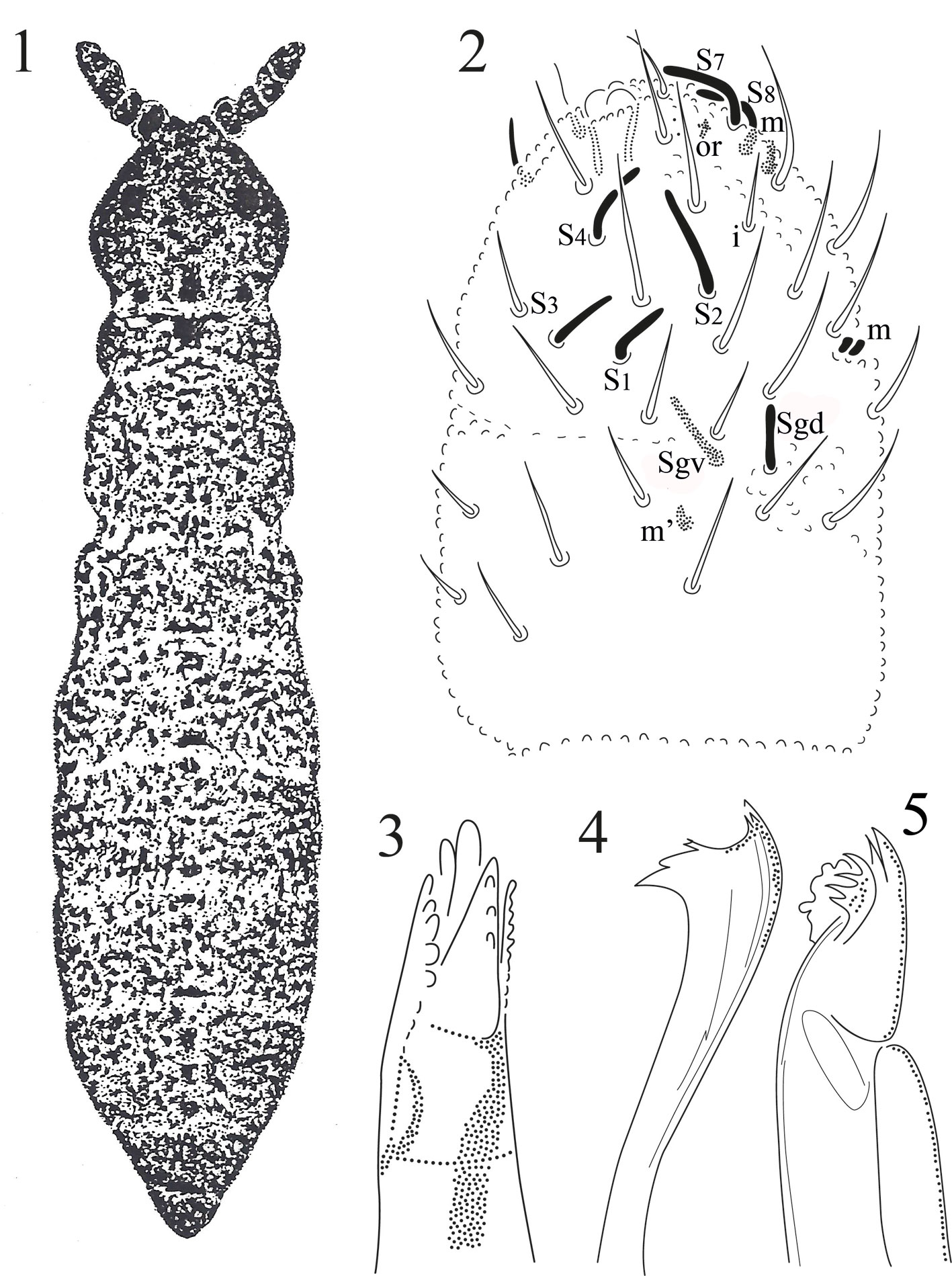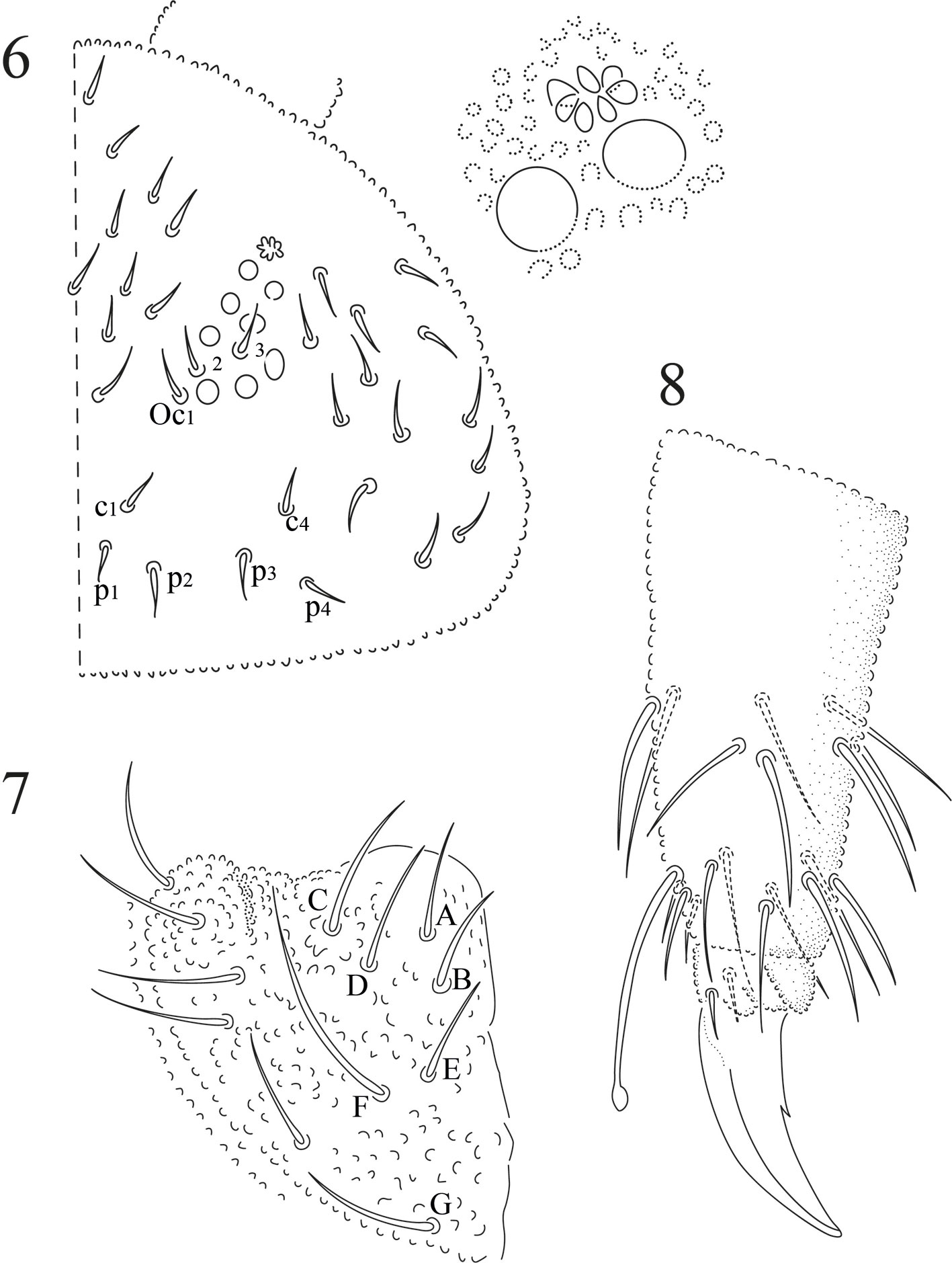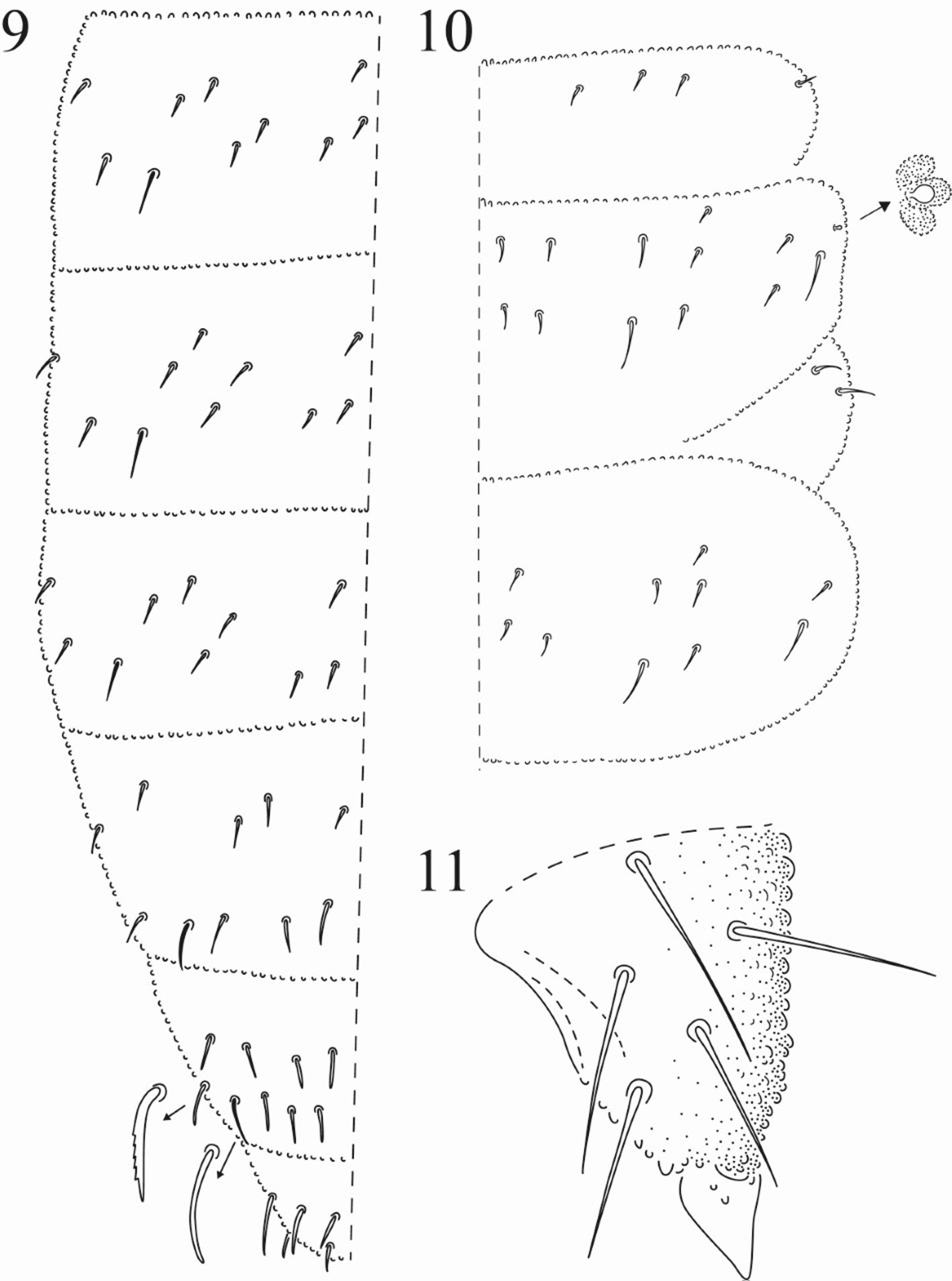First Mexican species of Pseudachorudina (Collembola: Neanuridae: Pseudachorutinae) from Mapimí Desert, State of Durango
José G. Palacios-Vargas *
Laboratorio de Ecología y Sistemática de Microartrópodos, Departamento de Ecología y Recursos Naturales, Facultad de Ciencias, Universidad Nacional Autónoma de México, Circuito Exterior s/n, Ciudad Universitaria, 04510 México City, Mexico
*Corresponding author: troglolaphysa@hotmail.com (J.G. Palacios)
Received: 6 September 2019; accepted: 13 January 2020
http://zoobank.org/urn:lsid:zoobank.org:pub:1982C7DB-752C-483B-A88C-1B7C9615D216
Abstract
Pseudachorudina navarretei sp. nov. from Mapimí Desert, Durango, México, is described. It is similar to the American species P. texensis and P. ignotus Christiansen and Bellinger, 1980, all of them with 1 dorsal strong capitated tenent hair on tibiotarsi. It differs in the shape of the maxillary lamellae, one with 4 sharp big teeth and one semispherical with 5 stocky teeth while P. texensis has both lamellae toothed and similar; P. ignotus has only 1 serrate lamella and the maxillary capitulum is elongated. The new species has 5 long dental setae; P. texensis has 4 short and P. ignotus has 6 of different sizes.
Keywords: Chaetotaxy; Arid soil; Taxonomy; Pitfall traps
© 2020 Universidad Nacional Autónoma de México, Instituto de Biología. This is an open access article under the CC BY-NC-ND license
Primera especie mexicana de Pseudachorudina (Collembola: Neanuridae: Pseudachorutinae) del desierto de Mapimí, estado de Durango
Resumen
Se describe Pseudachorudina navarretei sp. nov., procedente del desierto de Mapimí, Durango, México. Es similar a las especies norteamericanas P. texensis y P. ignotus Christiansen y Bellinger, 1980 por la presencia de una fuerte seda capitada dorsal en los tibiotarsos. La especie nueva difiere en la forma de las lamelas maxilares, una con 4 grandes dientes agudos y la otra semihemisférica con 5 dientes fuertes, mientras que P. texensis tiene ambas lamelas dentadas y similares; P. ignotus solo tiene 1 lamela aserrada y 1 capítulo maxilar alargado. La especie nueva tiene 5 sedas largas dentales; P. texensis 4 sedas cortas y P. ignotus 6 de diferentes tallas.
Palabras clave: Quetotaxia; Suelo árido; Taxonomía; Trampas de caída
© 2020 Universidad Nacional Autónoma de México, Instituto de Biología. Este es un artículo Open Access bajo la licencia CC BY-NC-ND
Introduction
About 100 species of the family Neanuridae are known from Mexico (Palacios-Vargas, 2013) and more than 1,540 have been described all over the world (Bellinger et al., 2019). In this family, the members of Pseudachorutinae are represented by almost 500, with some genera very widely distributed. The specimens of Pseudachorutinae have a very variable development of furcula, number of eyes, presence of postantennal organ and mouth parts of very different shape. Mandibles are small with a few apical teeth and no molar surface; maxillae are often styliform and sometimes with well-developed lamellae with teeth or feathered. Mouth cone can be prominent with a beak shape, with an elongation of the labrum and labium. In the subfamily Neanurinae, the mouthparts were used by Cassagnau (1982) to establish the different lineages (actual tribes) according to their development and to propose a new phylogenetic model (Cassagnau, 1983). But for the Pseudachorutinae, the use of mouth parts morphology for the division of tribes proposed by Massoud (1967) has been questioned by several authors. Therefore, it is important to continue the study of members of this group from different biogeographic regions and propose the division into tribes.
Members of Pseudachorudina are known from several regions, but 5 out of 14 have been described from Europe; 2 species are known from the USA, and this is the first time it is recorded from Northern Mexico with a new species.
The State of Durango is located in the northern part of Mexico with 2 important biological reserves. The first one is La Michilia between 23°25’and 23°30’ N, 104°15’ and 104°21’ W; the elevation is about 2,350 and 2,850 m with Pinus-Quercus forest. About 30 species of springtails have been identified from this location (Montejo Cruz pers. comm.) and were collected by Palacios-Vargas and Najt (1986) with different techniques, other were collected using pitfall traps (Terrón-Sierra & Palacios-Vargas, 1991). Mapimí Biological Reserve is in the desert of Mapimí (Palacios-Vargas & Najt, 1986) and is located close to the border between Chihuahua and Coahuila, between 26°29’ and 26°52’ N, 103°32’ and 103°58’ W. The altitude is between 1,100 and 1,350 m asl. From this desert, only 9 springtails have been included in the data base of our Collembola collection, done after the compilation of Palacios-Vargas (2013). Including the new species here described, only 40 springtails are known from Durango.
Abbreviations used in this contribution are: Ant. = antennal segment; Abd. = abdominal segment; m, microsensillum, microsensilla; or = oranite; PAO = postantennal organ; S = sensilum, sensilla; Sgd = dorsal guard sensillum; Sgv = ventral guard sensillum; Th.= thoracic segment; Tita. = tibiotarsus, tibiotarsi.
Materials and methods
Specimens were collected using pitfall traps in the Mapimí desert by Dr. Pedro Aguilar. They were preserved in 75% alcohol and donated to the author. Later, they were cleared on KOH at 10% and in warm lactophenol acid and mounted under cover slides in Hoyer’s solution. The morphology was studied under a phase contrast Carl Zeiss microscope and drawings were made with the aid of a camera lucida.
Description
Collembola
Neanuridae
Pseudachorutinae
Pseudachorudina Stach, 1949
Diagnosis. Neanurids similar to Pseudachorutes, with strong blue pigmentation, except ventral side, furcula and legs which are less pigmented. Ant. III and IV dorsally fused, subapical vesicle present, with sensilla of normal shape and no ventral file. Ant. Organ III with 2 guard sensilla, 1 dorsal and 1 ventral; 2 microsensilla and 1 ventral microsensillum. 8+8 eyes. Postantennal organ is always present with 5 to 20 vesicles arranged in one ellipse. Mouth cone truncate, more elongated than members of Brachystomella, but shorter than Pseudachorutes. Mandible with 5-8 sharp teeth, maxilla with a median capitulum and with 2 or 3 complicated lamellae, toothed or feathered. Tibiotarsus very rare with one dorsal apical tenent hair. Unguis similar to Pseudachorutes with or without inner and lateral teeth; ventral tube with 4 + 4 setae, retinaculum and furcula always present and well developed; mucro with more or less coarsely granulation. Sixth abdominal segment visible in dorsal view, no anal spines.
Type species: Pseudachorudina alpina Stach, 1949
Pseudachorudina navarretei sp. nov. (Figs. 1-11)
http://zoobank.org/urn:lsid:zoobank.org:act:8252351B-
5EB3-42E4-B450-F1067BF9398E
Description. Body length (n = 8) 1.1 mm. Color: very dark blue with pigment in patches of granules. Ocular patches black (Fig. 1). Most setae short almost acuminate (5-22 μm). Sensorial setae about 30 μm. Cuticle with strong granulation.
Ant. I with 7 dorsal setae, Ant. II with 12 in 2 whorls; Ant. III with 19 setae, sensorial organ with 2 short cylindrical microsensilla and 2 guard sensilla, Sgv and microsensillum far from organ. Ant. IV with 6 sensilla, 1 microsensillum, a subapical organ “or” and apical bulb trilobed (Fig. 2), no ventral file. 8+8 eyes. PAO in rosette shape, slightly bigger than one eye, with 5-8 vesicles (Fig. 6). Ratio PAO: eye = 1.2. Labrum with 2/4,4,4 setae. Mouth cone truncate like Brachystomella; labium with setae A-G, but without tuberculate seta L (Fig. 7). Mandible with 3 small apical teeth and 3 bigger basal teeth (Fig. 4). Maxilla with a capitulum with 2 big teeth and 3 smaller; 2 lamellae, one with 4 sharp teeth and other with 5 thick teeth (Figs. 3, 5). Legs chaetotaxy from I to III, subcoxae with 0,1,2 setae; coxae with 3,8,8; trochanters with 6,6,6; femora with 12, 11 and 10 (1 ventral modified like a long acuminate tenent hair); Tita. with 19, 19 and 18, dorsally with 1 strong dorsal capitate tenent hair (Fig. 8). Unguis with a median tooth and no lateral teeth. Body dorsal setae almost acuminate, those posterior slightly crenulated. Head chaetotaxy in Fig. 6; Th. I-III in Fig. 10; Abd. I-VI in Fig. 9. Th. I with 3+3 dorsal setae. Sensorial setae from Th. II to Abd. V: 2,2/1,1,1,1,1. Th. II with 1 microsensillum laterally close to sensorial seta. Ventral tube with 4+4 setae, retinaculum with 3 + 3 teeth. Dens with 5 long setae. Mucro short, about 1/3 dens length, subtriangular, no lamellae (Fig. 11). Female genital plate with 3 + 3 pregenital setae, 10-12 circumgenital and 2 eugenital; males unknown. Anus terminal, no anal spines.

Taxonomic summary
Type material: holotype female (FC UNAM 22508) under slide, 8 female paratypes under slides (Collection of Facultad de Ciencias, UNAM, slides FC UNAM from 22509 to 22516). Type material is maintained at the author’s institution. Eight additional specimens under slides, from the same locality, are also kept. However, they are too transparent and damaged to represent types.
Type locality: Mexico: Durango: desierto de Mapimí, ex pitfall traps 15-VIII-1985, F. Aguilar col.
Variation: PAO with the following number of vesicles (frequency in parenthesis): 5+6 (1), 7+6 (5), 7+7 (2), 6+8 (1), 7+8 (2) in 11 specimens studied. Dens and mucro are often fused. Some dens with reduced mucro and in one case mucro was bifid. Some cases of chaetotaxy asymmetries were found.
Derivatio nominis: species dedicated to Dr. José Luis Navarrete Heredia, from Universidad de Guadalajara, for his enthusiasm in the organization of zoological congresses and the edition of the entomological magazine Dugesiana.

Discussion
To date, 15 species of Pseudachorudina are known, 7 have a maxilla with toothed lamellae (alpina, berninii, evansi, ignota, nepalica, texensis and navarretei sp. nov.), 4 have feathered lamellae (angelieri, dahli, falteronensis and meridionalis), and 4 species should be revised as their maxillae are not well described (brunnea, mabirensis, osextara and pacifica).
Pseudachorudina navarretei sp. nov. belongs to the group of species with toothed lamellae, and is close to ignota and texensis by the presence of 1 clearly capitate tenent hair on tibiotarsi and the presence of a reduced mucro, which is well developed in all the other members of the genus. This new species is easy to differentiate from the American members of this genus, because its maxilla has only 2 lamella; one with 4 sharp big teeth and one semispherical with 5 stocky teeth while P. texensis (after the figures of Christiansen and Bellinger [1980]) has both lamella toothed and similar. P. ignotus has only 1 lamella serrate and the maxillary capitulum is elongated. The new species has 5 long dental setae; P. texensis has 4 short setae and P. ignotus has 6, 2 basal short and the other much longer.

Acknowledgments
To Blanca E. Mejía Recamier (UNAM, México) for clearing and mounting specimens under slides and María Martínez (México) for the preparation of final drawing plates. Maira Montejo (Project LE002 Conabio, Facultad de Ciencias, UNAM) verified the data bases of Mexican Collembola from Durango. Luis Parra, former professor of English at UNAM checked and corrected the preliminary version of this manuscript. The author thanks the two anonymous reviewers who gave criticism and suggestions for improving this contribution.
References
Bellinger, P. F., Christiansen, K. A., & Janssens, F. (2019). Checklist of the Collembola of the World. 12-XII-2019. http://www.collembola.org
Cassagnau, P. (1982). Sur les Neanurinae primitifs suceurs et les lignées qu’en dérivent (Collembolles). Travaux du Laboratoire d’Ecobiologie des Arthropodes Edaphiques, 3, 1–11.
Cassagnau, P. (1983). Un nouveau modèle phylogénétique chez les Collemboles Neanurinae. Nouvelle Revue d’Entomologie, 13, 3–27.
Christiansen, K. A., & Bellinger, P. F. (1980). Part 1. Poduridae and Hypogastruridae. The Collembola of North America North of the Rio Grande, Grinnell College, Iowa.
Massoud, Z. (1967). Monographie des Neanuridae, Collemboles Poduromorphes à pièces buccales modifiées. Biologie de l’Amérique Austral, 3, 7–399.
Palacios-Vargas, J. G. (2013). Biodiversidad de Collembola (Hexapoda: Entognatha) en México. Revista Mexicana de Biodiversidad, 85 (Supl.), 220–231. https://doi.org/10.7550/rmb.32713
Palacios-Vargas, J. G., & Najt, J. (1986). Collembola de la reservas de la biosfera mexicana. I. Neanurinae. Folia Entomológica Mexicana, 68, 5–27. https://doi.org/10.21829/abm22.1993.668
Terrón-Sierra, R. A., & Palacios-Vargas, J. G. (1991). Colémbolos atraídos a necrotrampas NTP-80 en la Reserva de la Biosfera “La Michilia”, Durango, México. Folia Entomológica Mexicana, 81, 337–339.



